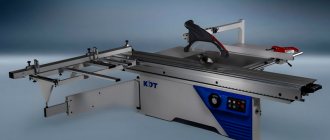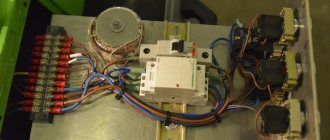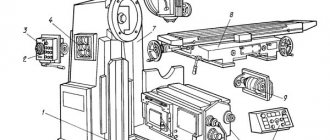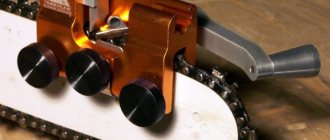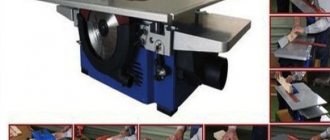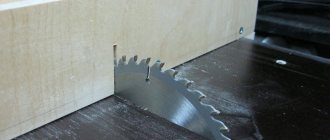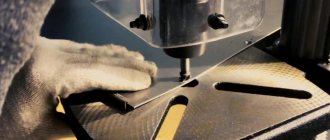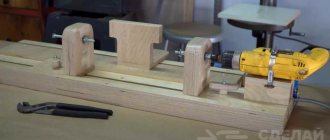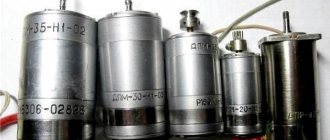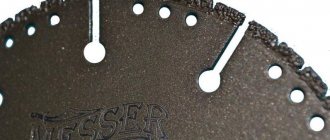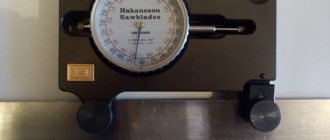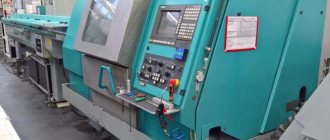Distinctive features
A vertical format-cutting machine differs from its horizontal “brother” primarily in the vertical position of the working field on which the material to be cut is placed. And also because its moving parts are sawing units.
The operating principle of a vertical format cutting machine is as follows:
- The sheet material is firmly fixed in the working field, located almost vertically and secured to a durable frame.
- The saw unit moves with high precision along a given route, cutting in both horizontal and vertical planes.
The simplest compact models of machines provide for horizontal supply of material manually.
How to make a sawing machine with your own hands
When considering what equipment is required for high-quality independent furniture production, you should pay attention to the format-cutting machine. Many experts claim that if necessary, you can make a format-cutting machine yourself. Let's look at all the features of creating a wood processing machine yourself.
Homemade format-cutting machine with chip ejector
Features of movable steel
Great difficulties arise when creating a movable table. This surface acts as a reference surface, so it must withstand the impact. The load is placed on the carriage itself and the connecting element.
Dimensional 3D drawingDimensional drawing of the formatting machine and frame
Due to the design features, a fairly large load occurs at the point of contact between the balls and rollers. That is why, when creating your own format-cutting machine, you should use special guides that do not create backlash during operation. The accuracy of processing directly depends on this.
The following can be used as guides:
- rollers;
- balloons;
- combination of rollers and balls.
The most popular design is a combination of an aluminum carriage and steel guides on which linear bearings are mounted.
When making your own guides, the following points should be taken into account:
- the guides themselves can be made in the form of steel strips;
- The guides are installed in such a way that the balls can be placed in two channels.
The scheme under consideration allows us to reveal the capabilities of the equipment in question, since the load can be effectively absorbed in any direction. In order for them to work for several years, you should choose a material for their manufacture that has been subject to heat treatment.
Recently, guides have begun to be made of plastic. The required precision of movement can only be achieved if an aluminum profile with a large number of internal ribs is used.
In conclusion, when considering the question of how to make a format cutting machine, we note that home-made versions are significantly inferior to industrial models in terms of accuracy and functionality.
This is due to the fact that due to the presence of a large number of moving elements, the rigidity of the structure is significantly reduced. It is quite difficult to independently create guides that will ensure precise positioning of the workpiece.
Making a sawing machine
There are quite a lot of advantages to such a machine, however, there is also a disadvantage - the high cost of high-precision equipment. Not all novice manufacturers have the opportunity to purchase such a mechanism, so many decide to make a format-cutting machine with their own hands.
FRS design
To manufacture a machine that will meet the requirements for quality and speed of production, you need to be prepared to spend on materials and be able to use drawings, because the unit consists of complex mechanisms and volumetric structures.
Required items:
How to make a tabletop sawing machine
To come in
Already registered? Sign in here.
There are currently 0 users on the page
There are no users viewing this page.
This device is intended for cutting slabs in furniture production. Structurally, it consists of a sawing section and a base. The saw unit is represented by a pair of disks with axes of rotation located at the same level. In this case, the diameters of the disks are different, rotation is performed in opposite directions - towards each other.
How to prevent chipping from chipboard
A material such as laminated chipboard has the harmful property of leaving chips on the ends after cutting.
The only way to avoid such trouble is to increase the rotation speed of the saw or slowly feed the saw onto the material. However, not all so simple. Chipboard sheets consist of pressed sawdust and a laminating layer.
The laminating layer is a thin but very durable material, and the pressed sawdust is a thick and soft layer.
Using a powerful motor, the soft sawdust is cut like butter, causing the hard laminate to simply chip off. The solution is to use 2 saws with different rotation speeds or cut slowly.
Everything is clear with the speed at which the saw feeds onto the material, but using two saws is worth understanding. It is worth noting that here you will need drawings of format cutting machines. To achieve the desired result, the laminate cutting disc is placed so that it cuts no more than 2 mm, and the rotation speed is achieved by reducing the disc or using a more powerful motor.
Cutting part
To cut the base layer, a large disk with a cutting depth of up to 40 mm is used. It is worth noting that this version of the sawing mechanism allows you to achieve a cutting speed of 1 m in 10 seconds.
Sawing rules
First you need to choose a cutting method.
Be sure to carry out the following preparation (cutting):
- To protect the laminated surface of the board from damage during operation, you need to prepare masking tape or tape;
- for marking workpieces - a ruler and a pencil;
- From the ends of the slab, mark future cutting points with a pencil;
- in order to prevent chips from appearing, you need to stick masking tape or adhesive tape to the cut area;
- after gluing the tape, connect the preliminary marking points with a pencil;
- prepare sandpaper to finalize the cut lines.
The following rule applies not to preparation, but to actions after cutting, but is general for any method: if irregularities are found on the edges, then they need to be processed with a file or rasp. The ends resulting from cutting are covered with veneer with a pattern similar to the pattern of the laminated coating.
What not to saw
Chipboard cannot be sawed using an angle grinder, which is also called a grinder. When working with this tool, there is a high risk of injury, especially when using large diameter discs. Injury can also occur when the tool guard is removed from the tool.
Options for using the cutting mechanism
There are 3 options, thanks to which the vertical sawing machine cuts materials:
- feeding the saw onto the material – the saws are located under the table;
- feeding the saw onto the material – the saws are located above the table;
- feeding material to the saw – the saws are located under the table.
In the case of feeding the saw onto the material, which is located above the table, the motor and cutting discs are fixed to the carriage. The carriage is mounted on skids placed at the required height, which allow the entire cutting structure to be held and moved along the plane of the table. Skids or guides can be made of channel or powerful pipes.
The location of the saw under the table, which feeds the material, also assumes the presence of guides and a carriage moving along them. The difference between this arrangement is that the dust collector system is hidden under the table and does not interfere with the movement of large objects.
When cutting is carried out by feeding material to the saw, a powerful mechanism is required to move the sheets. In this case, the carriage for moving is a table with legs on rollers. It is worth noting that the design of such a sawing mechanism requires more space and has less throughput.
Sequence of work
First, a strong metal frame is prepared that can serve as the basis of the machine. For this purpose, it is best to use a channel. The blanks are selected so that the result is a unit 6.5 - 6.7 m long, 2.5 m wide, and a height of eighty to one hundred and ten centimeters.
The main guide of the cutting equipment and the floor guide are designed and mounted on the bed. For them, it is best to use pipes whose dimensions are 6 cm in diameter, 6.5 m in length, and wall thickness - 5 mm. The moving part of the desktop should be made movable along guides.
During the work process, it will be used to feed sheet material. This section can be moved manually or an additional CNC motor can be installed. Cutting lines along the length should be provided from three meters.
This parameter can be increased or reduced by simply changing the size of the guides.
Read also: Thread pitch on an angle grinder
A pair of saws are hung on the bed - for the main cut and trimming. They are mounted on a saw unit so that rotation occurs in the opposite direction from the movement of a pair of asynchronous motors. It is recommended to provide the ability to tilt the block by forty-five degrees, for which you should use a rotating device on the sawing block.
You should choose electric motors carefully, because they will be intended to rotate the saws. Their power must be at least 2.9 kW. The motor must rotate the main saw at a speed of at least 5,000 revolutions per minute, and the scoring saw must produce three thousand revolutions more.
When creating equipment, it is best to use saw blades with a diameter of twenty-five centimeters, which will make it possible to cut not only laminated chipboard and trim sheets, but also to use a machine for sip panels.
Advantages
Due to their design features, vertical panel saws are endowed with obvious advantages:
- Significant savings in work space. An important factor for small and medium-sized enterprises. Due to the vertical arrangement of the machine, you can save up to two-thirds of the working area.
- High cutting accuracy. On high-quality models it can reach a value of one tenth of a millimeter over a length of one meter of cut workpiece.
- Possibility of cutting several slabs at the same time. The number of sheets is limited only by the depth of cut.
- Increased cutting length. It can exceed six meters, which allows cutting sheets of increased sizes.
You can learn more about the benefits in more detail and clearly from the video.
Comparison of three popular vertical panel saws
The vertical panel saw model MJ6325A manufactured by the Chinese company Gonqyou is an example of an inexpensive model. The maximum cutting length is 2450 mm. Materials can only be cut in a vertical direction. Equipped with a device for smoothly changing speed, a V-shaped guide to ensure more accurate cutting.
Vertical format cutting machine (vertical saw) model CPME 2B 20/40 from BALA (Norway). Equipped with a cutting disk and a disk cutter mounted on separate spindles and quickly replaced from the control panel. Capable of cutting various materials: aluminum composite panels, chipboard, laminated chipboard, MDF and others. Can make both vertical and horizontal cuts. Ultra-high cutting accuracy – deviation from the specified size by no more than 0.01 mm! Cutting depth – from 0 to 20 mm. Equipped with an aspiration system - “suction” of chips formed during cutting.
Vertical format cutting machine model CUT 1260 manufactured by HOLZ HER, Germany. The powerful tube-type frame houses high-precision guides that ensure smooth movement of the saw portal. The maximum length of the material to be cut is 6300 mm, thickness – 60 mm. Lower rollers made of hardened steel, raised by pressing a pedal, facilitate the installation of the plate intended for cutting. For cutting small-sized workpieces up to 42 mm thick, it is equipped with a separate folding support. To ensure high cleanliness of cutting laminated materials, the machine is equipped with a “Super Cut” unit (an alternative to a scoring saw), which cuts the coating using two knives made of hard alloys. The system of automatic movement of the portal carries out a given cutting stroke by “pressing one button”, after which the portal returns to its original position, or returns to its original position.
In addition to cutting “standard” materials for the manufacture of cabinet furniture, vertical format cutting machines are used for cutting plastic and aluminum-based materials (Dibond, Alucobond).
Do-it-yourself format cutting machine: drawings, videos, photos
As the Pyroprinter project develops, our team has to optimize some processes. We have long needed to make some kind of machine or device for quickly and accurately dismantling plywood for subsequent milling. I won’t bore you, I’ll immediately show you the result we got:
We made such a format-cutting machine with our own hands. Let me clarify right away - we are not a furniture manufacturer, where the format machine is one of the main tools.
And it comes with the requirement to have a scoring saw blade for cutting without the slightest chips and high productivity.
For us, cutting plywood (and other sheet materials) is an auxiliary production process that does not require high quality cutting.
Those who have ever encountered cutting sheets of plywood (1.5 * 1.5 m) know that sawing is accompanied by a number of difficulties:
- The sheet is bulky and requires a lot of space if cut horizontally;
- When cutting across the grain, many chips appear;
- Maintaining an even line from edge to edge by simply sawing along the drawn line is not easy - the cut floats a little.
The initial requirements were simple: you need a budget version of a format-cutting machine that you can assemble with your own hands. The cut should be straight and without chips. When cutting, spend a minimum of time setting dimensions. The formatter should take up minimal space.
Purpose of the format cutting machine
The main functions of a format-cutting machine are to form an even cut on the surface of laminated chipboard or fiberboard. This places special demands on edge quality.
Externally, the structure resembles a simple sawmill. The difference lies in the rigid fixation of the workpiece relative to the cutting components. To increase quality, there are two discs of different diameters. One of them is larger than the other and rotates in the opposite direction. This makes it possible to reduce the likelihood of chips on the end of the wooden surface.
When making a homemade structure, the following points should be taken into account:
- equipment stability during operation;
- availability of measuring tools for preliminary cutting of wooden sheets.
- desktop dimensions. They directly depend on the dimensions of the workpiece;
- security measures. This applies to equipment and operating personnel. To remove chips, there must be an exhaust mechanism; the cutting components are located under a special cover.
An important factor is the preliminary calculation of all structural elements. It must perform its functions depending on the degree of load. One of the disadvantages of a format cutting machine is the inability to form shaped cuts. This requires other types of equipment.
When analyzing factory models, the thickness of the material being processed and its specific density should be taken into account. This will affect the choice of saw blades.
Why did you decide to make a format-cutting machine with your own hands, rather than buying a ready-made one?
The cheapest ready-made formatter with a horizontal sheet arrangement costs 220 thousand rubles. (Jet brand).
An example of a finished horizontal formatter. With a sheet of plywood it takes up a lot of space
This design has a scoring saw. And in theory, it was possible to assemble something similar yourself from a ready-made circular (sawing) machine or a hand-held circular saw. The simplest cheap circular saw costs 7 thousand rubles, something more serious will cost 30 thousand rubles.
But! To use this, you need at least 6-8 square meters. meters of free space on the floor (for the movement of the sheet and the space next to it so that the operator can move freely).
And free space in our workshop is problematic (let me remind you that cutting plywood is an auxiliary function for us). Therefore, only a vertical format cutting machine was suitable for us.
The simplest vertical formatter will cost 230 thousand rubles.
A budget version of a vertical format that we didn’t really like
The one we liked costs about 300 thousand rubles (moreover, it is a budget one, since serious format devices cost from 500 rubles to 1.5 million). True, I found a homemade version on Avito on a metal frame with a simple hand-held circular saw attached to it for 100 thousand rubles. (+delivery).
Yes, there is also a simple ready-made solution - sawing along a special bar (if your circular saw model provides grooves for the bar and a bar for your saw, in principle, exists). This way the cut will be even.
But there are some inconveniences associated with the bus: it takes a long time to mark and position, your hands are under tension from the weight of the circular saw, you will have to unravel it either in a horizontal position of the sheet or somehow fix it at a distance from the floor, it is not convenient to use a long tire for cutting short pieces plywood, etc.
